

Instituto Nacional de Estadistica. (Spanish Statistical Office) Participants in INE surveys The statistical information Agriculture and environment Science and technology Demography and population Economy Industry, energy, construction Labour market Standard and life conditions (CPI) Services Society International data Statistical compilation Economic indicators.

IMF iCal Calendar 2015 News flash. Economic Insight Greater China 6 November 2015 (Chinese) 十三五之歌 The 13 WHAT - A song about China's 13th 5-year-plan.
元大寶華經濟研究院. 景氣觀測-財團法人商業發展研究院. 中国经济信息网. 國發會-景氣指標查詢系統. 國發會-景氣指標查詢系統. 中华人民共和国国家统计局. Economic forecasting. Economic forecasting is the process of making predictions about the economy.

Forecasts can be carried out at a high level of aggregation—for example for GDP, inflation, unemployment or the fiscal deficit—or at a more disaggregated level, for specific sectors of the economy or even specific firms. Overview[edit] Many institutions engage in economic forecasting, including international organisations such as the IMF, World Bank and the OECD, national governments and central banks, and private sector entities, be they think-tanks, banks or others. Some forecasts are produced annually, but many are updated more frequently. Economists select which variables are important to the subject material under discussion. The economist typically considers risks (i.e., events or conditions that can cause the result to vary from their initial estimates).
Purpose[edit] Forecasts are used for a variety of purposes. Sources of forecasts[edit] Global scope[edit] U.S. forecasts[edit] The U.S. Forecast methods[edit] Forecasting and Econometric Models: The Concise Encyclopedia of Economics. An econometric model is one of the tools economists use to forecast future developments in the economy.
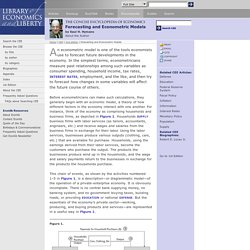
In the simplest terms, econometricians measure past relationships among such variables as consumer spending, household income, tax rates, interest rates, employment, and the like, and then try to forecast how changes in some variables will affect the future course of others. Before econometricians can make such calculations, they generally begin with an economic model, a theory of how different factors in the economy interact with one another. For instance, think of the economy as comprising households and business firms, as depicted in Figure 1. Households supply business firms with labor services (as tailors, accountants, engineers, etc.) and receive wages and salaries from the business firms in exchange for their labor.
Using the labor services, businesses produce various outputs (clothing, cars, etc.) that are available for purchase. Figure 1. How many years is “recent”? Saul H.
IMF warns of stagnation threat to G7 economies. The International Monetary Fund is warning that the weak recovery in the west risks turning into near stagnation after cutting its global economic growth forecast for the fourth successive year.
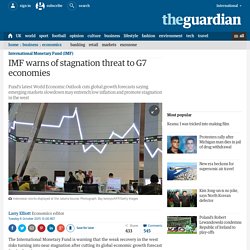
In its half-yearly update on the health of the world economy, the Washington-based fund predicted expansion of 3.1% in 2015, 0.2 points lower than it was expecting three months ago and the weakest performance since the trough of the downturn in 2009. “Six years after the world economy emerged from its broadest and deepest postwar recession, a return to robust and synchronised global expansion remains elusive,” said Maurice Obstfeld, the IMF’s economic counsellor. “Despite considerable differences in country-specific outlooks, the new forecasts mark down expected near-term growth rates marginally, but nearly across the board. Moreover, downside risks to the world economy appear more pronounced than they did just a few months ago.” IMF Survey : Uncertainty, Complex Forces Weigh on Global Growth.
Copper mill, Chile: Declining copper prices are weighing on outlook for emerging and developing commodity exporters (photo: Radius Images/Corbis) IMF Survey October 6, 2015 Global growth moderate and uneven, forecast at 3.1 percent this year, 3.6 percent in 2016Disparate fortunes between the advanced and emerging market and developing economiesLower commodity prices weigh on commodity exporters.
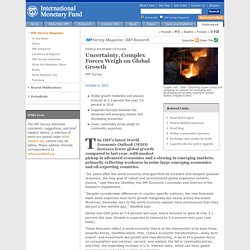
Economists React to U.S. GDP Growth: ‘Recovery Shifted Up a Few Gears’ Gross domestic product. A map of world economies by size of GDP (nominal) in USD, World Bank, 2014[1] Definition[edit] The OECD defines GDP as "an aggregate measure of production equal to the sum of the gross values added of all resident and institutional units engaged in production (plus any taxes, and minus any subsidies, on products not included in the value of their outputs).”[2] An IMF publication states that "GDP measures the monetary value of final goods and services—that are bought by the final user—produced in a country in a given period of time (say a quarter or a year).
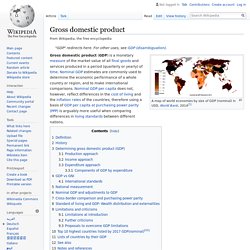
"[3] Economic growth. GDP real growth rates, 1990–1998 and 1990–2006, in selected countries.
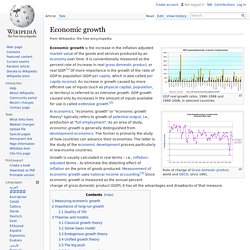
Economic growth is the increase in the inflation-adjusted market value of the goods and services produced by an economy over time. It is conventionally measured as the percent rate of increase in real gross domestic product, or real GDP.[1] Of more importance is the growth of the ratio of GDP to population (GDP per capita, which is also called per capita income). An increase in growth caused by more efficient use of inputs (such as physical capital, population, or territory) is referred to as intensive growth. GDP growth caused only by increases in the amount of inputs available for use is called extensive growth.[2] In economics, "economic growth" or "economic growth theory" typically refers to growth of potential output, i.e., production at "full employment".
Growth is usually calculated in real terms – i.e., inflation-adjusted terms – to eliminate the distorting effect of inflation on the price of goods produced. Research at the IMF. 行政院主計總處. 國家發展委員會. 中華民國經濟部(Ministry of Economic Affairs,R.O.C.)全球資訊網. 財團法人中華經濟研究院. 台灣經濟研究院全球資訊網.